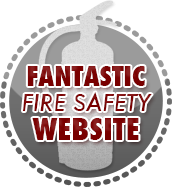Fire Extinguisher : 101
Class D Fires: How to Fight Them
| Home |
| About Fire Extinguishers |
| Using a Fire Extinguisher |
| Fire Prevention |
| Fire Hazards |
| First Aid for Fire |
| Financial Protection |
| Biggest Fires in History |
| Firefighters |
This site was voted:

by onlinefiresciencedegree.org
(scroll to 74 on the list)
This page provides information about class D fires. |
Fire classes or designations are used to educate the public on identifying the different types of fires, and the proper fire fighting methods to be used. Class D fires are those that involve flammable metals, a fuel that presents particular dangers and flames that can quickly spread to other combustible materials in the area. This class of fire is less common than class A and B. The flames must be attacked in a certain way to avoid rapid spreading, intense heat, and excessive damage.
Flammable
Metals
 Not
all metals are flammable. Some of the combustible metals are: magnesium,
titanium, uranium, potassium, calcium, sodium, and lithium.
Not
all metals are flammable. Some of the combustible metals are: magnesium,
titanium, uranium, potassium, calcium, sodium, and lithium.
The fuel that ignites class D fires is usually in the form of metal fines - tiny, thin pieces of metal, often shavings or metal dust left over from machining, that can spark a fire. Large pieces of combustible metals do not typically pose a risk of class D fires, since they easily disperse heat and are not subject to the conditions required for ignition.
Laboratories and industrial facilities must enforce precaution and prevent conditions that may spark fires of this class. They must also ensure that the appropriate equipment and fire extinguishers are available should a dangerous situation occur.
Fighting
Class D Fires
Similar to class C flames, water cannot be used on fires that
burn metal. Spraying water on a class D fire will actually serve to energize
the flames, potentially spreading the fire and creating additional heat
and damage.
The most effective way to fight class D fires is with dry powder extinguishing agents because they absorb heat and smother the flames, cutting off oxygen. By removing these two essential elements of the fire tetrahedron, the fire will be put out safely and rapidly.
Firefighting
Equipment
Fire extinguishers containing dry powder substances should be
on hand wherever combustible metals are present. These extinguishers are
not to be confused with those using dry chemical agents. Extinguishers
containing dry chemical agents can actually aggravate a class D fire.
Common dry powder substances that effectively douse metal fires include graphite in powder form and sodium chloride in granular form. Look for equipment that specify these substances on the label. Training should be provided to those who have to use them.
Protecting
your Home or Business against Class D Fires
Although fires fueled by metal are rare, being aware of the potential
risks is important. Because people are not expecting metal to burn or
for the flames to spread so quickly, a small class D fire can soon turn
into a very dangerous situation before appropriate action is taken. Educating
your family or staff about the conditions and dangers of this class of
fire is essential.
If combustible metals are present in your home or business, be sure to have rated fire extinguishing equipment nearby. And if those metals are present in small, easily ignitable forms (such as shavings or dust), avoid sparks in the area and design the space using the appropriate standards and codes.
Class D fires are dangerous and can spread quickly with surprising intensity. Be prepared and informed on the proper ways to combat the flames and avoid situations that can spark such a fire.